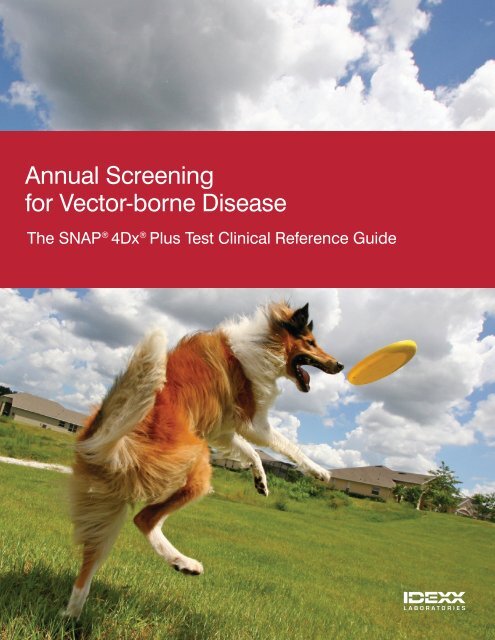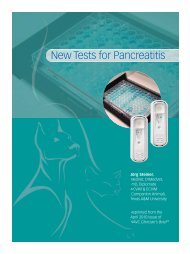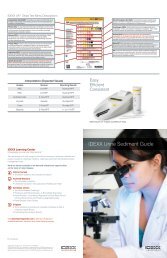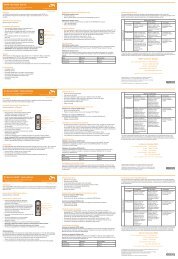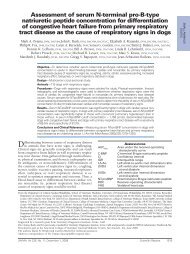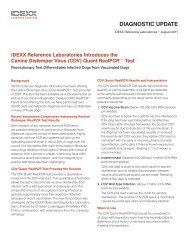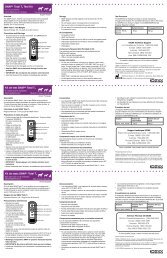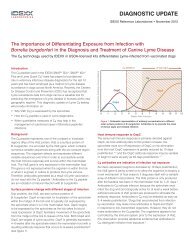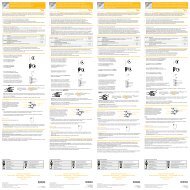SNAP 4Dx Plus Clinical Reference Guide - IDEXX Laboratories
SNAP 4Dx Plus Clinical Reference Guide - IDEXX Laboratories
SNAP 4Dx Plus Clinical Reference Guide - IDEXX Laboratories
Create successful ePaper yourself
Turn your PDF publications into a flip-book with our unique Google optimized e-Paper software.
Annual Screening<br />
for Vector-borne Disease<br />
The <strong>SNAP</strong> ® <strong>4Dx</strong> ® <strong>Plus</strong> Test <strong>Clinical</strong> <strong>Reference</strong> <strong>Guide</strong>
Every dog, every year<br />
For healthier pets and so much more. The benefits of vector-borne disease screening go far beyond the<br />
well-being of an individual pet. Adopting regular screening protocols at your practice can lead to a greater<br />
awareness and understanding of vector-borne disease in your community, while building the value of your<br />
practice with pet owners.<br />
Your patients<br />
Educating pet owners about the<br />
risk of vector-borne disease is an<br />
opportunity to stress the importance<br />
of screening and prevention.<br />
Your community<br />
Comprehensive annual screenings<br />
give you a current snapshot of how<br />
widespread certain diseases and tick<br />
species are in the area.<br />
Your practice<br />
Vector-borne disease screenings<br />
are the foundation of your practice’s<br />
preventive medicine programs and<br />
let you know what your patients are<br />
being exposed to over time, which<br />
leads to healthier patients and a<br />
stronger practice.
Know more with every result<br />
With the <strong>SNAP</strong> ® <strong>4Dx</strong> ® <strong>Plus</strong> Test, a positive result can also be an indication<br />
of ticks and other pathogens in your area.<br />
When you use the<br />
<strong>SNAP</strong> ® <strong>4Dx</strong> ® <strong>Plus</strong> Test<br />
as a screening tool,<br />
you may<br />
detect antibodies to<br />
these pathogens<br />
carried by<br />
these ticks<br />
that may also transmit<br />
other infections to<br />
dogs and people<br />
Geographic tick<br />
distribution as<br />
of 2011<br />
Ehrlichia ewingii<br />
Lone star tick<br />
Amblyomma<br />
americanum<br />
Ehrlichia chaffeensis<br />
Tularemia<br />
Rocky Mountain spotted fever<br />
STARI<br />
Anaplasma<br />
phagocytophilum<br />
Borrelia burgdorferi<br />
(Lyme disease)<br />
Deer tick or<br />
black-legged tick<br />
Ixodes scapularis<br />
Ixodes pacificus<br />
Bartonella spp.<br />
Babesia spp.<br />
Ehrlichia canis<br />
Anaplasma platys<br />
Brown dog tick<br />
Rhipicephalus<br />
sanguineus<br />
Babesia spp.<br />
Rocky Mountain spotted fever<br />
Ehrlichia canis<br />
American dog tick<br />
Dermacentor<br />
variabilis<br />
Rocky Mountain spotted fever<br />
Tularemia
Lyme disease<br />
Transmitted by the deer tick<br />
or black-legged tick, Lyme<br />
disease is caused by the<br />
bacterium Borrelia burgdorferi.<br />
<strong>Clinical</strong> signs may not appear<br />
until several months after<br />
infection. Lyme disease has<br />
been found throughout North<br />
America with cases ranging<br />
from mild to severe.<br />
Did you know?<br />
• The C 6 peptide used in the <strong>IDEXX</strong> <strong>SNAP</strong> ® 3Dx ® , <strong>SNAP</strong> ® <strong>4Dx</strong> ® <strong>Plus</strong> and<br />
Lyme Quant C 6<br />
®<br />
tests do not cross-react with the antibody response to<br />
commercially available Lyme vaccines. 1<br />
• Dogs with seroreactivity to both B. burgdorferi and Anaplasma<br />
phagocytophilum may have two times the risk of developing clinical illness<br />
than singularly infected dogs. 2<br />
Borrelia burgdorferi<br />
What to do with your <strong>SNAP</strong> ® result<br />
Primary vectors<br />
Ixodes scapularis<br />
Ixodes pacificus<br />
(deer tick or black-legged tick)<br />
Pathology<br />
Localizes in tissues of infected dogs<br />
<strong>Clinical</strong> presentation<br />
Lyme disease is a chronic infection<br />
with clinical signs that may present<br />
acutely:<br />
• Fever, anorexia, lethargy<br />
• Polyarthritis, lameness<br />
• Rapidly progressive renal failure<br />
• Neurologic syndromes<br />
Laboratory abnormalities<br />
• Elevated (≥30 U/mL)<br />
C 6 antibody level<br />
• Proteinuria<br />
WHAT<br />
TO DO<br />
NEXT?<br />
1<br />
DIAGNOSE*<br />
2TREAT<br />
3<br />
MONITOR<br />
<strong>Clinical</strong> signs and/or<br />
laboratory findings<br />
DO support Lyme disease<br />
(C 6 antibody level ≥30 U/mL)<br />
Doxycycline/tetracycline<br />
Retest C 6 antibody level<br />
with or without UPC<br />
in 6 months to confirm<br />
treatment success<br />
Positive result Infection is likely<br />
Determine C 6 antibody level with the Lyme Quant C 6 Test<br />
and evaluate for proteinuria (UPC)<br />
<strong>Clinical</strong> signs and/or<br />
laboratory findings<br />
DO NOT support<br />
Lyme disease<br />
(C 6 antibody level
Canine anaplasmosis<br />
Canine granulocytic anaplasmosis<br />
is caused by the bacterium<br />
Anaplasma phagocytophilum<br />
(transmitted by the deer tick or<br />
black-legged tick). Anaplasma<br />
platys (transmitted by the brown<br />
dog tick) is the cause of infectious<br />
cyclic thrombocytopenia.<br />
Did you know?<br />
• Many mammalian species, including humans, are susceptible to<br />
A. phagocytophilum infection.<br />
• Coinfection of Anaplasma species with other vector-transmitted<br />
pathogens may lead to more complex presentations and<br />
slower response to therapy.<br />
• A. platys infects canine platelets and is frequently seen as a<br />
coinfection with Ehrlichia canis.<br />
Anaplasma phagocytophilum<br />
Primary vectors<br />
Ixodes scapularis<br />
Ixodes pacificus<br />
(deer tick or black-legged tick)<br />
Anaplasma platys<br />
Most likely Rhipicephalus sanguineus<br />
(brown dog tick)<br />
What to do with your <strong>SNAP</strong> ®<br />
Positive result<br />
The dog has been exposed<br />
and may be infected<br />
Pathology<br />
Infects neutrophils<br />
<strong>Clinical</strong> presentation<br />
Can present acutely:<br />
• Fever<br />
• Anorexia<br />
• Lethargy<br />
• Polyarthritis, lameness<br />
• Neurologic signs<br />
Laboratory abnormalities<br />
• Thrombocytopenia<br />
• Lymphopenia<br />
• Increased liver enzymes<br />
Note<br />
Infects platelets<br />
Usually minimal clinical signs, but<br />
some dogs may have:<br />
• Fever<br />
• Uveitis<br />
• Petechia and ecchymoses<br />
• Epistaxis<br />
• Thrombocytopenia<br />
While not known to be chronic, experimental studies have shown<br />
persistent infection. 5,6<br />
WHAT<br />
TO DO<br />
NEXT?<br />
1<br />
DIAGNOSE*<br />
2TREAT<br />
3<br />
MONITOR<br />
4<br />
PREVENT<br />
Check for hematologic abnormalities<br />
(CBC and/or blood film) and changes<br />
in serum proteins<br />
<strong>Clinical</strong> signs and/or<br />
laboratory findings<br />
DO support<br />
anaplasmosis/ehrlichiosis<br />
Doxycycline/tetracycline<br />
Evaluate platelet count in 1 week;<br />
if no improvement, pursue other<br />
diagnoses<br />
Discuss disease prev
Canine ehrlichiosis<br />
Canine ehrlichiosis is caused<br />
by the bacteria Ehrlichia canis,<br />
(transmitted by the brown<br />
dog tick) and Ehrlichia ewingii<br />
(transmitted by the lone star tick).<br />
Canine Ehrlichia infections may<br />
progress to the subclinical phase,<br />
lasting days, months or years.<br />
Did you know?<br />
• Dogs coinfected with E. canis and A. platys were found to have more severe<br />
anemia and thrombocytopenia than dogs with either single infection. 6<br />
• In a study of healthy dogs with antibodies to E. canis, 39% were<br />
thrombocytopenic. 7<br />
• Chronic E. canis infections, if left untreated, can lead to<br />
bone marrow dysfunction or renal disease.<br />
anaplasmosis and ehrlichiosis results<br />
Negative result<br />
Exposure is unlikely<br />
<strong>Clinical</strong> signs and/or<br />
laboratory findings<br />
DO NOT support<br />
anaplasmosis/ehrlichiosis<br />
Not generally recommended<br />
Recheck CBC at wellness exams<br />
• Review benefits<br />
of tick prevention<br />
• Retest in 1 year<br />
Ehrlichia canis<br />
Primary vector<br />
Rhipicephalus sanguineus<br />
(brown dog tick)<br />
Pathology<br />
Infects monocytes<br />
<strong>Clinical</strong> presentation<br />
• Fever, anorexia, lethargy<br />
• Bleeding disorders<br />
• Polyarthritis, lameness<br />
• Lymphadenomegaly<br />
• Neurological signs<br />
Laboratory abnormalities<br />
• Anemia<br />
• Thrombocytopenia<br />
• Hyperglobulinemia<br />
• Proteinuria<br />
Note<br />
Ehrlichia ewingii<br />
Amblyomma americanum<br />
(lone star tick)<br />
Infects granulocytes<br />
• Fever, anorexia, lethargy<br />
• Polyarthropathy, lameness<br />
• Neurological signs<br />
• Thrombocytopenia<br />
Not known to be chronic, but<br />
experimental studies have shown<br />
persistent infection. 8<br />
ention strategies<br />
*Additional diagnostics may include PCR or IFA titer.<br />
See the Diagnostics for Sick Patients section of this guide<br />
for more information on serological and PCR testing.
Heartworm disease<br />
Dirofilaria immitis, the causative<br />
agent of heartworm disease,<br />
is transmitted by infected<br />
mosquitoes when D. immitis<br />
larvae are transferred to a<br />
healthy dog. Heartworm disease<br />
has no obvious clinical signs<br />
in the early stages, making<br />
preventive measures so much<br />
more important—especially as<br />
advanced infection may result<br />
in death.<br />
Did you know?<br />
• Despite availability of monthly preventives, prevalence rates of canine<br />
heartworm has remained consistent nationwide. 4<br />
• For more information and current recommendations on treating canine<br />
heartworm disease, go to heartwormsociety.org or capcvet.org.<br />
Dirofilaria immitis<br />
Primary vector<br />
Mosquito<br />
Pathology<br />
Infective larvae (L3) mature to adult<br />
worms in the heart and pulmonary<br />
arteries<br />
<strong>Clinical</strong> presentation<br />
Asymptomatic at first, later<br />
developing:<br />
• Mild, persistent cough<br />
• Lethargy<br />
• Exercise intolerance<br />
• Reduced appetite<br />
Laboratory abnormalities<br />
• Weight loss<br />
• Eosinophilia<br />
• Azotemia<br />
• Increased liver enzymes<br />
• Proteinuria<br />
WHAT<br />
TO DO<br />
NEXT?<br />
1<br />
DIAGNOSE<br />
2TREAT<br />
3<br />
MONITOR<br />
4<br />
PREVENT<br />
What to do with your <strong>SNAP</strong> ® result<br />
Positive result<br />
• Confirm with retest<br />
• Evaluate for microfilaria<br />
• Radiographs<br />
• CBC/Chemistry profile<br />
• Other tests as appropriate<br />
According to<br />
American Heartworm<br />
Society (AHS) guidelines<br />
Retest in 6–12 months<br />
• Assess heartworm<br />
antigen status<br />
• Assess cardiopulmonary<br />
disease<br />
<strong>Clinical</strong> signs DO support<br />
heartworm disease<br />
• Confirm with retest<br />
• Evaluate for microfilaria*<br />
• CBC/chemistry profile<br />
• Other tests as<br />
appropriate<br />
Treatment depends on<br />
supplemental test results<br />
If no definitive diagnosis,<br />
repeat diagnostics in<br />
1–3 months<br />
Negative result<br />
Follow AHS/CAPC guidelines on heartworm prevention<br />
*Less than 1% of infections will have microfilariae but not<br />
be antigenemic (source: American Heartworm Society).<br />
No clinical signs<br />
Infection unlikely<br />
Heartworm prevention<br />
Retest in 12 months
Annual screening with<br />
the <strong>SNAP</strong> ® <strong>4Dx</strong> ® <strong>Plus</strong> Test<br />
Screen your canine patients every year with the <strong>SNAP</strong> ® <strong>4Dx</strong> ® <strong>Plus</strong> Test to detect exposure to<br />
pathogens that cause heartworm disease, ehrlichiosis, Lyme disease and anaplasmosis.<br />
A pet’s screening result<br />
and what it means<br />
Quick tips to share with<br />
pet owners<br />
Positive result<br />
The dog has been exposed and may be infected<br />
Negative result<br />
Exposure unlikely<br />
• Check your dog for ticks daily.<br />
If you find a tick, remove it right<br />
away (ticks will gravitate to the<br />
head, ears and neck).<br />
• Use a tick preventive on your dog.<br />
WHAT<br />
TO DO<br />
NEXT?<br />
1<br />
DIAGNOSE<br />
2<br />
3<br />
4<br />
TREAT<br />
MONITOR<br />
PREVENT<br />
<br />
<br />
Perform additional tests to confirm infection<br />
<strong>Clinical</strong> signs and/or laboratory findings indicate either:<br />
Self-limiting infection<br />
No clinical signs or laboratory abnormalities<br />
Subclinical infection<br />
Apparently healthy dogs with laboratory abnormalities<br />
<strong>Clinical</strong> disease<br />
Infected dogs with clinical signs<br />
with or without laboratory abnormalities<br />
If necessary<br />
Retest in 6–12 months<br />
Discuss disease prevention strategies<br />
• Review benefits<br />
of prevention<br />
– preventive<br />
– vaccination<br />
• Retest in 1 year<br />
Depending on<br />
the results of a<br />
pet’s screening,<br />
additional testing<br />
or therapies may<br />
be required.<br />
• Watch your dog closely for<br />
changes in behavior or appetite<br />
and call your veterinarian with<br />
any concerns.<br />
• Talk with your veterinarian about<br />
ticks and vector-borne disease<br />
in your area.<br />
• If your pet’s test results are<br />
negative, congratulations! Keep<br />
up the good work with regular<br />
preventive screenings and daily<br />
tick checks.<br />
Go to dogsandticks.com<br />
for more information.
Diagnostics for sick patients<br />
Serology and PCR testing options—For a sick dog presenting with clinical signs consistent with a vectorborne<br />
disease, it’s important to consider both serology and PCR testing because they are complementary.<br />
Benefits and limitations of each diagnostic method:<br />
Serology<br />
Polymerase chain reaction (PCR)<br />
Measures Antibody response of host Nucleic acid (DNA) from pathogen<br />
Benefits<br />
Limitations<br />
Useful for screening as well<br />
as diagnosis of infection<br />
<strong>Clinical</strong> signs may precede<br />
a measurable antibody<br />
response<br />
Specifically identifies pathogens<br />
indicating active infection<br />
A negative PCR result does not<br />
necessarily rule out infection<br />
Dogs with ehrlichiosis and anaplasmosis may present with clinical signs<br />
at different times after infection. Which sick dog are you dealing with?<br />
Using serology and<br />
PCR together improves<br />
your ability to make a<br />
complete and accurate<br />
diagnosis.<br />
Positive result<br />
Infection or<br />
Recrudescence<br />
PCR<br />
Dog A<br />
presents<br />
Dog B<br />
presents<br />
Serology<br />
Time postinfection<br />
Dog C<br />
presents<br />
When to use the <strong>IDEXX</strong> RealPCR<br />
vector-borne disease panels:<br />
• Sick patients with clinical signs<br />
and/or laboratory abnormalities<br />
consistent with a vector-borne illness<br />
• Patients with subclinical infections<br />
based on history, physical exam,<br />
serology and clinical laboratory<br />
findings<br />
• Monitoring response to therapy—<br />
the Lyme Quant C 6<br />
®<br />
Test can<br />
indicate waning antibody levels,<br />
and for other pathogens, a negative<br />
PCR result indicates a reduction in<br />
pathogen load<br />
••<br />
No single test is sufficient for<br />
diagnosing an infectious disease<br />
in a sick patient. ••<br />
Edward Breitschwerdt, DVM, DACVIM*<br />
Professor, Internal Medicine<br />
College of Veterinary Medicine,<br />
North Carolina State University<br />
*Dr. Breitschwerdt has a business relationship with <strong>IDEXX</strong> pursuant to which he<br />
receives compensation from <strong>IDEXX</strong> from time to time. The views expressed in this<br />
brochure are solely those of Dr. Breitschwerdt.
1. O’Connor TP, Esty KJ, Hanscom JL, Shields P, Philipp MT. Dogs vaccinated with common<br />
Lyme disease vaccines do not respond to IR 6, the conserved immunodominant region of the<br />
VlsE surface protein of Borrelia burgdorferi. Clin Diagn Lab Immunol. 2004;11(3):458–462.<br />
2. Beall MJ, Chandrashekar R, Eberts MD, et al. Serological and molecular prevalence of<br />
Borrelia burgdorferi, Anaplasma phagocytophilum, and Ehrlichia species in dogs from<br />
Minnesota. Vector-Borne Zoonotic Dis. 2008;8(4):455–464.<br />
3. Straubinger RK. PCR-based quantification of Borrelia burgdorferi organisms in canine tissues<br />
over a 500-day postinfection period. J Clin Microbiol. 2000;38(6):2191–2199.<br />
4. Verdon DR. Heartworm infection continues its climb, survey reports. DVM Newsmagazine.<br />
February 1, 2006.<br />
5. Egenvall A, Lilliehöök I, Bjöersdorff A, Engvall EO, Karlstam E, Artursson K, Heldtander<br />
M, Gunnarsson A. Detection of granulocytic Ehrlichia species DNA by PCR in persistently<br />
infected dogs. Vet Rec. 2000;146(7):186–190.<br />
6. Gaunt S, Beall M, Stillman B, et al. Experimental infection and co-infection of dogs with<br />
Anaplasma platys and Ehrlichia canis: hematologic, serologic and molecular findings.<br />
Parasit Vectors. 2010;3(1):33.<br />
7. Hegarty BC, Diniz PPVP, Bradley JM, Lorentzen L, Breitschwerdt EB. <strong>Clinical</strong> relevance of<br />
annual screening using a commercial enzyme-linked immunosorbent assay (<strong>SNAP</strong> 3Dx)<br />
for canine ehrlichiosis. JAAHA. 2009;45(3):118–124.<br />
8. Yabsley MJ, Adams DS, O’Connor TP, Chandrashekar R, Little SE. Experimental<br />
primary and secondary infections of domestic dogs with Ehrlichia ewingii. Vet Microbiol.<br />
2011;105(3–4):315–321.<br />
Tick images supplied by the Armed Forces Pest Management Board. afpmb.org. American dog tick (Dermacentor variabilis)<br />
photographer: Susan E. Ellis, USDA-APHIS-PPQ. Black-legged tick (Ixodes scapularis), lone star tick (Amblyomma<br />
americanum) and brown dog tick (Rhipicephalus sanguineus) photographer: James L. Occi.<br />
© 2011 <strong>IDEXX</strong> <strong>Laboratories</strong>, Inc. All rights reserved. • 09-69074-02 • All ®/TM marks are owned by <strong>IDEXX</strong> <strong>Laboratories</strong>, Inc.<br />
or its affiliates in the United States and/or other countries. The <strong>IDEXX</strong> Privacy Policy is available at idexx.com.


